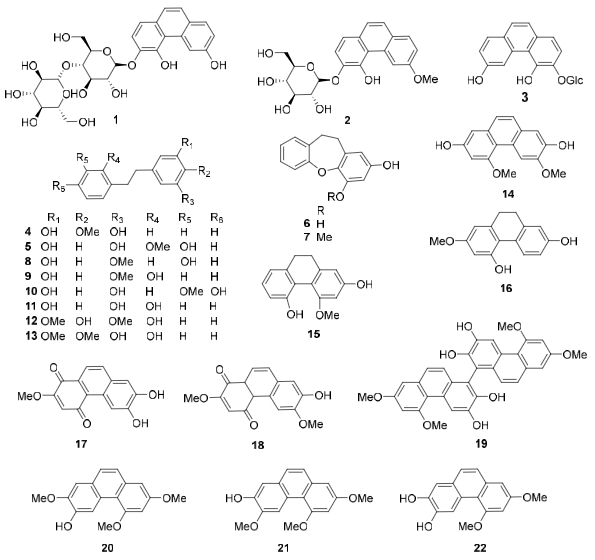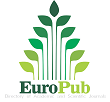Recent advances on chemical constituents of Dioscorea opposita and their biological activities
DOI:
https://doi.org/10.18686/fnc.v1i2.66Keywords:
Dioscorea opposita; chemical constituents; biological activities; research progressAbstract
Dioscorea opposita is a famous medicinal and edible plant that contains polysaccharides, stilbenes, diarylheptanoids, steroids, lignans, and terpenoids. It has many biological activities, such as anti-oxidation, enhancement of immunity, and hypoglycemic activity. In this paper, the research progress on the chemical constituents of D. opposita and their biological activities was reviewed. This review provides a scientific basis for the further development and utilization of D. opposita.

Downloads
Published
How to Cite
Issue
Section
License
Copyright (c) 2023 Menghuan Ge, Yuan Ruan, Miao Liu, Li Wang, Chunnan Wen, Bingji Ma

This work is licensed under a Creative Commons Attribution-NonCommercial 4.0 International License.
References
1. Wang J, Xu J. Research progress on the composition and pharmacological effects of Chinese yam polysaccharides (Chinese). Journal of Jilin Medical University 2018; 39(4): 304–306.
2. Li S. Fully Hand-Painted Color Illustration Collection of “Compendium of Materia Medica” (Chinese). China Medical Science Press; 2016. pp. 1277–1278.
3. Miao Q. Revise and Annotation of Compilation of Four Seasons (Chinese). China Agriculture Press; 1981. p. 54.
4. Zhang Y, Sun Y, Ge F, et al. Chinese yam resource survey and morphological identification (Chinese). Beijing Journal of Traditional Chinese Medicine 2018; 37(5): 463–467, 481.
5. Feng X, Huang L, Ge X, et al. A study on the origin and evolution of authentic Chinese yam (Chinese). China Journal of Chinese Materia Medica 2008; 33(7): 859–862.
6. Zhang P. Study on the Structure, Physicochemical Properties, and Antioxidant Activity of Polysaccharides from Dioscorea Opposita Residue (Chinese) [Master’s thesis]. Henan Agricultural University; 2020.
7. Chen M, Liu W, Chou G, et al. Advances in studies on chemical constituents and pharmacological activities of Dioscorea opposita Thunb (Chinese). Acta Chinese Medicine and Pharmacology 2020; 48(2): 62–66.
8. Fan X, Hou Y, Jia S, et al. Research progress on chemical components of Chinese yam and pharmacological effects of saponins (Chinese). Chinese Journal of Information on Traditional Chinese Medicine 2021; 38(9): 79–84.
9. Yang Y, Sun Y, Sun J, et al. Research progress on pharmacological effects of active ingredients of Chinese yam (Chinese). Chinese Wild Plant Resources 2022; 41(12): 55–60.
10. Wang R, Ma F. Investigative progress of Chinese yam polysaccharide (Chinese). Chemical Research 2019; 30(5): 547–550.
11. Wang R. Structural Identification and Activity Evaluation of Chinese Yam Polysaccharide (Chinese) [Master’s thesis]. Henan University; 2021.
12. Liu Z. Study on the Isolation, Purification, Anti-Aging Activity and Expression Regulation of Klotho Gene from Chinese Yam Polysaccharide (Chinese) [Master’s thesis]. Zhengzhou University; 2019.
13. Zheng KYZ, Zhang ZX, Zhou W, et al. New phenanthrene glycosides from Dioscorea opposita. Journal Of Asian Natural Products Research 2014; 16(2): 148–152. doi: 10.1080/10286020.2013.837459
14. Sautour M, Mitaine-Offer AC, Miyamoto T, et al. A new phenanthrene glycoside and other constituents from Dioscorea opposita. Chemical and Pharmaceutical Bulletin 2004; 52(10): 1235–1237. doi: 10.1248/cpb.52.1235
15. Yang MH, Yoon KD, Chin YW, et al. Phenolic compounds with radical scavenging and cyclooxygenase-2 (COX-2) inhibitory activities from Dioscorea opposita. Bioorganic & Medicinal Chemistry 2009; 17(7): 2689–2694. doi: 10.1016/j.bmc.2009.02.057
16. Ma C, Wang W, Chen YY, et al. Neuroprotective and antioxidant activity of compounds from the aerial parts of Dioscorea opposita. Journal of Natural Products 2005; 68(8): 1259–1261. doi: 10.1021/np050021c
17. Liu J. Study on the Chemical Components of the Aerial Parts of Chinese Yam and Their Inhibitory Effects on α-Glucosidase (Chinese) [Master’s thesis]. Xinxiang Medical University; 2016.
18. Zhang S, Wu D, Li H, et al. Rapid identification of α-glucosidase inhibitors from Dioscorea opposita Thunb. peel extract by enzyme functionalized Fe3O4 magnetic nanoparticles coupled with HPLC-MS/MS. Food & Function 2017; 8(9): 3219–3227. doi: 10.1039/C7FO00928C
19. Wang Z. Study on the Chemical Composition of Dried Ginger and Phylloxera (Chinese) [Master’s thesis]. Anhui University; 2010.
20. Cui W, Wang Y, Li Z, Guo Y. Two new diarylheptane derivatives from Rhizoma Zingiberis (Chinese). Acta Pharmaceutica Sinica 2018; 53(1): 100–103.
21. Sun Y, Peng M. Research progress on the preventive and therapeutic effects of curcumin and its derivatives in liver-related diseases (Chinese). Acta Pharmaceutica Sinica 2014; 49(11): 1483–1490.
22. Cao Y, Li H, Hao Z, et al. Two new diarylheptanoids and a new phenylhexanol derivative from the bulbils of Dioscorea opposita Thunb. and their α-glucosidase inhibitory activity (Chinese). Phytochemistry Letters 2021; 44: 142–148. doi: 10.1016/j.phytol.2021.06.016
23. Feng W, Han Z, Wang Z. Research on chemical components of Dioscorea opposite (Chinese). Chinese Traditional and Herbal Drugs 2018; 49(21): 5034–5039.
24. Zhang L, Bai B, Liu X, et al. α-Glucosidase inhibitors from Chinese Yam (Dioscorea opposita Thunb.). Food Chemistry 2011; 126(1): 203–206. doi: 10.1016/j.foodchem.2010.10.100
25. Bai B, Li M, Wang Y, Liu X. Studies on chemical components of Dioscorea opposite (Chinese). China Journal of Chinese Materia Medica 2008; 33(11): 1272–1274.
26. Bai B, Liu X, Wang Y, Li M. Study on the chemical components of Dioscorea opposita Thunb. (Ⅱ) (Chinese). Chemical Research 2008; 19(3): 67–69.
27. Feng W, Li F, Guo M, et al. Chemical composition study of Dioscorea opposita Thunb (Chinese). Modernization of Traditional Chinese Medicine and Meteria Medica 2017; 19(4): 658–662.
28. Ren Y, Cao Y, Zhang B, et al. Chemical constituents and antitumor activity from stems and leaves of Dioscorea opposita (Chinese). Chinese Traditional and Herbal Drugs 2020; 51(4): 918–924. doi: 10.7501/j.issn.0253-2670.2020.04.015
29. Feng W, Li F, Guo M, et al. A new pyrazine derivative from Dioscorea opposite Thunb (Chinese). Acta Pharmaceutica Sinica 2017; 52(8): 1299–1301.
30. Li M, Wang Y, Ma P, et al. 1,5-Dimethyl citrate monohydrate from Dioscorea opposita Thunb. Acta Crystallographica Section E 2007; 63(12): o4632. doi: 10.1107/S1600536807055535
31. Wang Y. Study on the Chemical Composition of Dioscorea Opposita Thunb Herbal Extract and the Interaction between Several Natural Phenolic Compounds and Proteins (Chinese) [Master’s thesis]. Henan University; 2006.
32. Nagai T, Suzuki N, Nagashima T. Antioxidative activity of water extracts from the yam (Dioscorea opposita Thunb.) tuber mucilage tororo. European Journal of Lipid Science and Technology 2006; 108(6): 526–531. doi: 10.1002/ejlt.200500231
33. Liu Y, Li H, Fan Y, et al. Antioxidant and antitumor activities of the extracts from Chinese Yam (Dioscorea opposita Thunb.) flesh and peel and the effective compounds. Journal of Food Science 2016; 81(6): H1553–H1564. doi: 10.1111/1750-3841.13322
34. Yu L, Zhang J, Jiao J, et al. Effect of nano yam polysaccharide on the blood glucose and blood lipid in rats. Pakistan Journal of Pharmaceutical Sciences 2020; 33: 481–487.
35. Nishimura N, Tanabe H, Yamamoto T, Fukushima M. Raw Chinese yam (Dioscorea opposita) promotes cecal fermentation and reduces plasma non-HDL cholesterol concentration in rats. Journal of Nutritional Science and Vitaminology 2011; 57(5): 340–347. doi: 10.3177/jnsv.57.340
36. Yang MH, Chin YW, Chen HS, et al. Anti-adipogenic constituents from Dioscorea opposita in 3T3-L1 cells. Biological and Pharmaceutical Bulletin 2014; 37(10): 1683–1688. doi: 10.1248/bpb.b14-00216
37. Amat N, Amat R, Abdureyim S, et al. Aqueous extract of dioscorea opposita thunb. normalizes the hypertension in 2K1C hypertensive rats. BMC Complementary and Alternative Medicine 2014; 14(36): 1–10. doi: 10.1186/1472-6882-14-36
38. Sun Y. Isolation, Purification and Mechanism Study of Anti-Inflammatory Active Substances from Chinese Yam (Chinese) [Master’s thesis]. Nanjing University of Chinese Medicine; 2020.
39. Huang R, Shen M, Yue Y, et al. Physicochemical characterization and immunomodulatory activity of sulfated Chinese yam polysaccharide. International Journal of Biological Macromolecules 2020; 165(Part A): 635–644. doi: 10.1016/j.ijbiomac.2020.09.213
40. Hu W, Wu S, Li H, et al. Effects of Chinese yam peel on serum biochemical, immunological indices, and tissue structure of carassius auratus (Chinese). Freshwater Fisheries 2020; 50(3): 79–86.
41. Zhang N, Liang T, Jin Q, et al. Chinese yam (Dioscorea opposite Thunb.) alleviates antibiotic-associated diarrhea, modifies intestinal microbiota, and increases the level of short-chain fatty acids in mice. Food Research International 2019; 122(8): 191–198. doi: 10.1016/j.foodres.2019.04.016
42. Li Q, Li K, Hu T, et al. 6,7-dihydroxy-2,4-dimethoxyphenanthrene from Chinese yam peels alleviates DSS-induced intestinal mucosal injury in mice via modulation of the NF-κB/COX‑2 signaling pathway. Journal of Agricultural and Food Chemistry 2021; 69(16): 4720–4731. doi: 10.1021/acs.jafc.1c00487
43. Li P, Xiao N, Zeng L, et al. Structural characteristics of a mannoglucan isolated from Chinese yam and its treatment effects against gut microbiota dysbiosis and DSS-induced colitis in mice. Carbohydrate Polymers 2020; 250: 116958. doi: 10.1016/j.carbpol.2020.116958
44. Zeng M, Zhang L, Miao L, et al. Estrogenic effects of the extracts from the Chinese Yam (Dioscorea opposite Thunb.) and its effective compounds in vitro and in vivo. Molecules 2018; 23(2): 11. doi: 10.3390/molecules23020011
45. Wang R, Li X, Ren Z, et al. Characterization and antibacterial properties of biodegradable films based on CMC, mucilage from Dioscorea opposite Thunb. and Ag nanoparticles. International Journal of Biological Macromolecules 2020; 163: 2189–2198. doi: 10.1016/j.ijbiomac.2020.09.115
46. Li X, Ren Z, Wang R, et al. Characterization and antibacterial activity of edible films based on carboxymethyl cellulose, Dioscorea opposite mucilage, glycerol and ZnO nanoparticles. Food Chemistry 2021; 349: 129208. doi: 10.1016/j.foodchem.2021.129208
47. Lim JS, Oh J, Yun HS, et al. Anti-neuroinflammatory activity of 6,7-dihydroxy-2,4-dimethoxy phenanthrene isolated from Dioscorea batatas Decne partly through suppressing the p38 MAPK/NF-κB pathway in BV2 microglial cells. Journal of Ethnopharmacology 2022; 282: 114633. doi: 10.1016/j.jep.2021.114633
48. Yang MH, Yoon KD, Chin YW, et al. Neuroprotective effects of Dioscorea opposita on scopolamine-induced memory impairment in in vivo behavioral tests and in vitro assays. Journal of Ethnopharmacology 2009; 121(1): 130–134. doi: 10.1016/j.jep.2008.10.010




.jpg)
.jpg)

